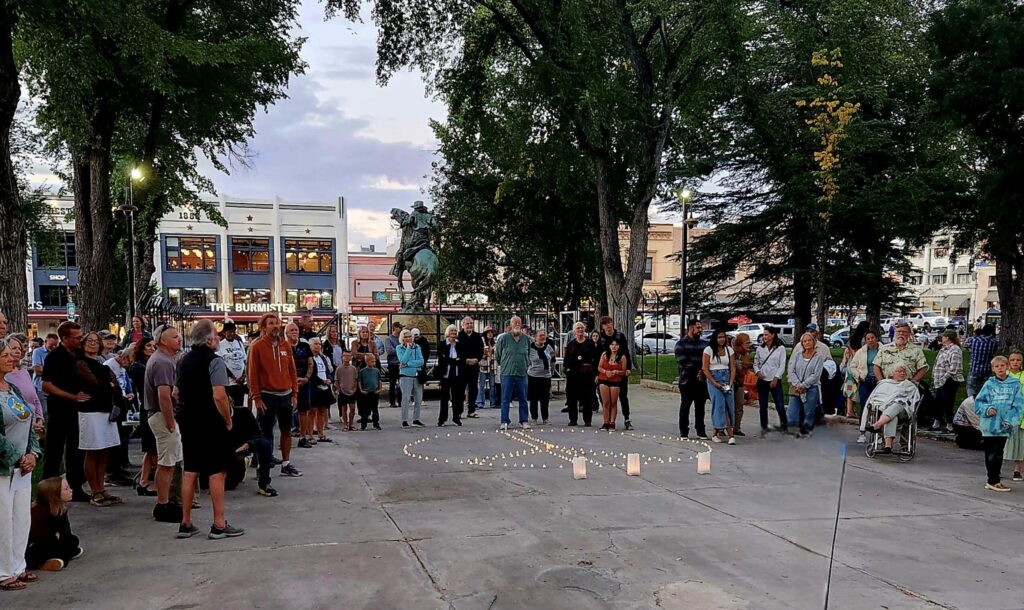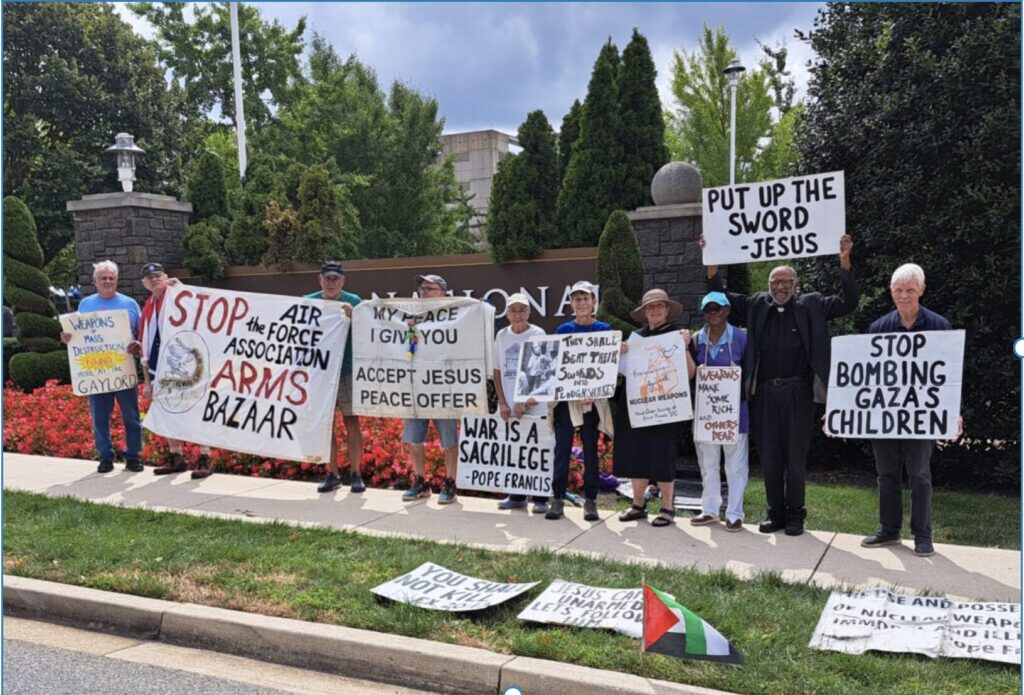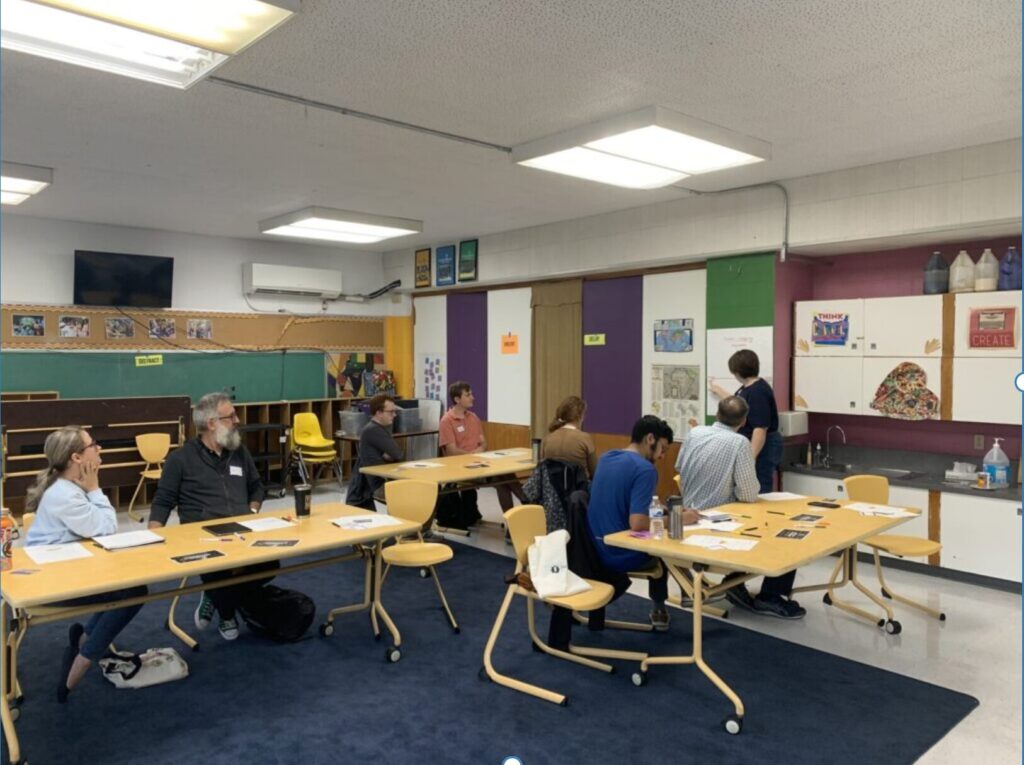A Better World is Possible: Over 5000 Actions Offer a Glimpse of a Possible Non-Violent World

Photo: Campaign Nonviolence
by Rivera Sun
The following article appeared originally in the Campaign for Nonviolence Newsletter on November 4, 2024. It is reposted here under Creative Commons license (CC BY 4.0 International).
At a time of horrific violence, tens of thousands of people in hundreds of cities and towns took a stand for peace during Campaign Nonviolence Action Days.
During Campaign Nonviolence Action Days, Sept. 21 to Oct. 2, tens of thousands of people in hundreds of cities and towns took a public stand for peace and active nonviolence. In a world reeling from war and violence, it’s a much-needed effort.
It’s easy to overlook its importance. When more than 40,000 people have been slaughtered in Gaza this past year, what good does it do to hold peace concerts, art-making or candlelight vigils?
More than you think.
Peace and conflict studies researcher Johann Galtung articulated different types of violence. Direct violence is physical, such as gun violence, domestic abuse, fist fights, war. Structural violence is the systems and policies that cause harm and destruction like poverty, low wages, lack of affordable housing and subsidizing fossil fuels amidst the climate crisis. Cultural violence is the ideas, beliefs and values that justify the other types of violence, including racism, supremacy, classism, climate denialism, militarism and more.
These three types of violence are deeply connected. Long before the bomb is dropped on terrified children in a warzone, it is built by weapons makers and paid for by tax dollars and justified by the belief that it was necessary for so-called defense. Belief in the moral legitimacy of the military is propagandized through popular entertainment (movies, video games, music, books) and society norms (holidays, war parades, fighter jet flyovers of sports games, military recruitment posters in schools and post offices). This pattern repeats through issues of gun violence, racial injustice, police brutality, bullying and even existential threats like the climate crisis.
If we want to break this cycle, we need to reestablish a culture of nonviolence, one that challenges and transforms the violence that has infiltrated every aspect of our lives. It requires confronting direct and structural violence, and challenging the beliefs and ideas of cultural violence that justify them.
Campaign Nonviolence was launched to do exactly that. Founded in 2013 to “build a culture of peace and active nonviolence, free from war, poverty, racism and environmental destruction,” Campaign Nonviolence offers a way for seemingly disparate groups working on a wide range of injustices, abuses and harms to see how their issue connects with others. It’s also one of the few initiatives that illustrate how the issues, the solutions and the way to make change are all connected. If we want to end violence in all its forms, we’re going to need nonviolence and nonviolent solutions in all of its many forms, too.

Peace-themed art crawls, signing peace declarations, mayors giving peace proclamations, planting peace poles, etc. are all ways to push back against the culture of war, violence and militarism that serve as the default setting of the United States (and many other nations). These types of actions complement the efforts to abolish nuclear weapons, move money out of weapons, call for a ceasefire in Gaza (and other places), disrupt weapons expos, protest at military bases and manufacturing plants — all of which were also part of the Campaign Nonviolence Action Days 2024.
Now in its 11th year, Campaign Nonviolence Action Days collaborated with over 100 organizations to mobilize more than 5,239 actions and events in 2024. Tens of thousands of people participated in challenging, dismantling, replacing and healing from violence. They used the tools of nonviolent action (marches, rallies, boycotts, strikes, protests, etc.) to advance nonviolent solutions (restorative justice, renewable energy, unarmed peacekeeping, violence de-escalation, living wages, etc.) and worked to confront, dismantle and replace systems of violence.
The framework of “oppose and propose” is a powerful aspect of how these groups, organizations and individuals make change. Many groups use nonviolent action to object to the forms of violence causing harm in our world. Over the 12 days that stretched between the International Day of Peace (Sept. 21) and the International Day of Nonviolence (Oct. 2), they protested against fossil fuel pipelines and financing. They coordinated citizen mapping efforts on plastic pollution. They held highway overpass banner actions calling for dam removals to save salmon and orcas. They denounced genocide, war and militarism, weapons and gun violence.
At the same time, numerous groups proposed solutions. They gave their communities a taste of a culture of nonviolence with teach-ins, school-wide de-escalation trainings, healing circles in jails, listening circles for racial justice, peace literacy trainings, public art events, a march to affirm racial and cultural diversity, regenerative agriculture, mutual aid efforts and much more. They helped people turn off violent films and tune into the Global Peace Film Festival, Peace Week livestreams or virtual talks. They went on a Neighborhood Peace Procession with Meta Peace Team in Detroit. They de-escalated violence in tense situations and hot conflict zones in the U.S. and abroad with Cure Violence and Nonviolent Peaceforce.

Some of the best actions combined both frameworks of oppose and propose, such as the Footballs Not Firearms March and Rally with kids in Philadelphia. They filled sidewalks around schools with chalk messages against violence and for nonviolence. They broke down social isolation and bullying with friendship and social cohesion efforts in hundreds of schools. They got their city council and mayor to declare their city opposed to violence and willing to make strides toward becoming a Nonviolent City.
These actions demonstrated that nonviolence isn’t about wishful thinking or being nice. It’s about pragmatic solutions, effective alternatives and powerful practices that can help us deal with conflict and injustice without relying on violence.
And at a time when gun violence is the leading cause of death for children in the United States, when the U.S. government spends more than a trillion dollars a year on war, weapons and genocide; when the climate crisis poses an existential threat to all life on Earth; when the forces of violence actively recruit through the propaganda of movies, video games, military recruiters and gun sellers; when racially-motivated police brutality, mass incarceration and migrant detention affects millions; when millions of people in the richest nation on earth face hunger, poverty and homelessness; when the myth of violence falsely claims that it is the best and only solution, every act of nonviolence counts.
Campaign Nonviolence is a long-term movement seeking to dismantle the entire culture of violence and all its destructive outgrowths. We seek a time when the systems and structures of our world are supportive, creative, healing, affirming, nourishing, peaceful, sustainable and liberatory. With actions small and large, creative and oppositional, challenging and constructive, we’re reclaiming our culture person by person, piece by piece, unleashing the power of active nonviolence that exists in all of us.
Rivera Sun is the editor of Nonviolence News, the author of “The Dandelion Insurrection” and other novels, and a nationwide trainer in strategy for nonviolent movements. www.riverasun.com
A Better World Is Possible is an occasional feature of the Amherst Indy that offers snapshots of creative undertakings, community experiments, innovative municipal projects, and excursions of the imagination that suggest possible interventions for the sundry challenges we face in our communities and as a species. This feature complements our occasional column by Boone Shear, who writes Becoming Human.
Have you seen creative approaches to community problems or examples of things that other communities do to make life better for their residents that you think we should be talking about? Send your observations/suggestions to amherstindy@gmail.com. See previous posts

“Those who will think deeply and reflect carefully, with the imagination to dream and the courage to seek out new solutions to problems facing both mankind and the earth itself, are invited to join a new intellectual, moral and spiritual ‘ascent’ to explore new realms of understanding; to search and find the key for turning mankind back from the edge of an abyss towards which the whole of humanity is fast approaching!”
“What constrains the highest of human aspirations is rarely imagined but if the catalyst with the necessary authority to realize the dream was ever revealed, who would care enough to believe with sufficient courage and conviction to act? Unfortunately the world has usually preferred the soft, the easy and more convenient ways of intellectual vanity, political correctness, wokeism and spiritual confectionery than the honesty and courage to question and confront human nature itself!”
So yet a nobler task awaits thy hand,
for what can war but endless war still breed
till truth and right from violence be freed?
And publick faith clear’d from the shameful brand
Of publick fraud. John Milton
https://www.lavitanuova.org.uk
I love ‘oppose and propose’! Imagining what else is possible for us humans, other than more of the same-old, same-old, is invaluable.
Thanks so much, Art and the INDY, for running this piece.